Porto Alegre: Difference between revisions
| Line 328: | Line 328: | ||
[[File:Pepsionstage2.jpg|thumb|right|[[Pepsi]] [[nightclub]].]] |
[[File:Pepsionstage2.jpg|thumb|right|[[Pepsi]] [[nightclub]].]] |
||
[[File:Opiniao.jpg|thumb|right|Opinião [[bar]].]] |
[[File:Opiniao.jpg|thumb|right|Opinião [[bar]].]] |
||
Porto Alegre is well known in Brazil for its diverse [[nightlife]]. The city's clubs, pubs, bars and restaurants provide [[entertainment]] for a wide range of tastes and budgets, going from the cheap, traditional beer-'n-bite in a corner bar to all-night raves, and classy nightclubs. |
Porto Alegre is well known in Brazil for its diverse [[nightlife]]. The city's clubs, pubs, bars and restaurants provide [[entertainment]] for a wide range of tastes and budgets, going from the cheap, traditional beer-'n-bite in a corner bar to all-night raves, and classy nightclubs. The nightlife here is similar to that of New York City, but on a micro-scale. In the "SoHo" area of Porto Alegre, there is a block full of great bars, [[restaurant]]s and [[club]]s.<ref>[http://www.world66.com/southamerica/brazil/portoalegre Nightlife POA city]</ref> |
||
[[Bar]]s, some with live [[music]] and most with a predominantly young and trendy clientele, are spread out along, and just off, alongside the Parque Farroupilha and near the Federal University. Favourites change constantly, but the Doce Vicio, and, for dancing, the Ocidente, are usually lively. Be warned, though, that things don't get going until around llpm. Throughout the year, Porto Alegre's numerous Centros de Tradição Gaúcha organize traditional meals, music and [[dance]] [[performance]]s. Tourist offices have only limited information on the events, but full details are available from the Movimento Tradicionalisto Gaticho. |
[[Bar]]s, some with live [[music]] and most with a predominantly young and trendy clientele, are spread out along, and just off, alongside the Parque Farroupilha and near the Federal University. Favourites change constantly, but the Doce Vicio, and, for dancing, the Ocidente, are usually lively. Be warned, though, that things don't get going until around llpm. Throughout the year, Porto Alegre's numerous Centros de Tradição Gaúcha organize traditional meals, music and [[dance]] [[performance]]s. Tourist offices have only limited information on the events, but full details are available from the Movimento Tradicionalisto Gaticho. |
||
Revision as of 13:51, 6 August 2009
Porto Alegre | |
|---|---|
Municipality | |
| The Municipality of Porto Alegre | |
 Skyline of Porto Alegre | |
| Nickname(s): Porto (spoken), POA (written) | |
| Motto(s): Loyal and Valiant city of Porto Alegre | |
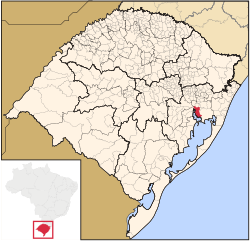 Location in the State of Rio Grande do sul | |
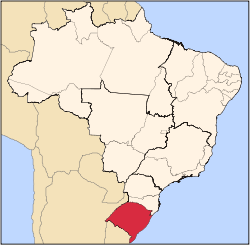 | |
| Country | |
| Region | South |
| State | |
| Founded | 1742 |
| Government | |
| • Mayor | José Fogaça (PPS) |
| Area | |
| • Municipality | 496.8 km2 (191.8 sq mi) |
| Elevation | 10 m (30 ft) |
| Population (2008) | |
| • Municipality | 1,430,220 (10th) |
| • Density | 2,815.6/km2 (7,292/sq mi) |
| • Metro | 3,959,807 |
| Time zone | UTC-3 (UTC-3) |
| • Summer (DST) | UTC-2 (UTC-2) |
| Postal Code | 90000-000 |
| HDI (2000) | 0.865–high |
| Website | Porto Alegre, Rio Grande do Sul |
Porto Alegre (lit. "Happy Port", ) is the tenth most populous municipality in Brazil and the capital city of the Brazilian state of Rio Grande do Sul. Porto Alegre is one of the most important cultural, political and economic centers of Southern Brazil. Two Mercosur countries, Argentina and Uruguay, border Rio Grande do Sul. It is also the centre of Brazil's fourth largest metropolitan area.
Porto Alegre was founded in 1742 by immigrants from the Azores, Portugal. In the late 19th century the city received many immigrants from other parts of the world, particularly Germany, Italy, and Poland. The vast majority of the population is of European descent.
The city lies on the eastern bank of the Rio Guaiba (Guaiba Lake), where five rivers converge to form the Lagoa dos Patos (Lagoon of the Ducks), a giant freshwater lagoon navigable by even the largest of ships. This five-river junction has become an important alluvial port as well as a chief industrial and commercial center of Brazil.
The port of Porto Alegre is important for transporting local produce. The "Gaucho capital" has a broad-based economy that lays particular emphasis on agriculture and industry. Agricultural production includes produce such as plums, peaches, rice and cassava grown on rural smallholdings. The shoe and leather industries are also important, especially in Novo Hamburgo, in the Metropolitan Region of Porto Alegre.
Porto Alegre has a long coastline on the Guaíba Lake, and its topography is punctuated by 40 hills. In the lake, a vast body of water, a maze of islands facing the city creates an archipelago where a unique ecosystem makes possible an exuberant wildlife. The city area concentrates 28% of the native flora of Rio Grande do Sul, with 9,288 species.[1] Among these, there are many trees which are the vestiges of the Atlantic Forest. Fauna is also diversified, specially in the islands and hills. The Portoalegrense environs include many parks, squares and wooded streets.
In recent years, Porto Alegre hosted the World Social Forum, an initiative of several Non Government Organizations.
The city


The city is located on a delta resulting from the junction of five rivers, officially called Guaíba Lake (popularly mentioned as a river too). Although its origins date from the mid-18th century, when immigrants from the Azores settled in the area, the city was officially established in 1742.[2]
Before this, Porto Alegre was the port of Viamão on the shore of Guaíba Lake. Its ancient name was Porto dos Casais (Port of the couples), and it was initially settled by Azorians. Many families of settlers also came from the city of Rio Grande (Big River) in the litoral Lagunar region, to the south, a military fortress at that time. Today Rio Grande is the most important port of the State of Rio Grande do Sul.
More than 70 neighborhoods (see below) are part of the city and 2/3 of the population are concentrated in the Zona Norte (Northern Zone), where most of the economic activity, including the city center, takes place.
Porto Alegre was the seat of the World Social Forum in 2001, 2002, 2003 and 2005. As the second largest city in southern Brazil, it is also an important industrial center in this geographical area. It is also a center for gaúcho (the popular name for natives of the State) history and culture, famous for its churrasco (barbecue) and chimarrão (a strong and hot tea prepared from erva mate). Important Brazilian universities, such as UFRGS, UFCSPA and PUCRS are located there. In 2000, the literacy rate was 97%.[3]
Porto Alegre is also one of the wealthiest cities in Latin America,[4] and one of the most diverse. It has welcomed immigrants from all over the world, the largest numbers coming from Portugal, Germany, Italy, Spain and Poland. There are also significant Arab and Jewish contingents in the population.
Climate
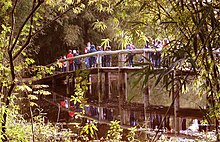
Porto Alegre is located in the subtropical area and so is called its climate. Average precipitation is high and regular throughout the year. Summer temperatures often rise above 32 °C (90 °F) and high levels of humidity make the season very muggy. The highest temperature ever registered was 40.7 °C (105.3 °F) in January 1943.
Humid subtropical climate is a climate zone characterized by hot, humid summers and chilly to mild winters. This climate type covers a broad category of climates, and the term "subtropical" may be a misnomer for the winter climate in the cooler areas within this category. Significant amounts of precipitation occur in all seasons in most areas. Winter rainfall (and sometimes snowfall) is associated with large storms that the westerlies steer from west to east. Most summer rainfall occurs during thunderstorms and an occasional tropical storm, hurricane or cyclone.
The winter reveals mild average temperatures, contrasting to the quite changeable, and many times sudden behavioral, windy and rainy weather which also characterizes this time of the year. Usual winter temperatures range from 5 °C (41 °F) to 25 °C (77 °F). Snow is very rare, sometimes confused with sleet. The main snowfall events in Porto Alegre were in 1879, 1910 and 1984.
The lowest temperature ever recorded was −4 °C (25 °F). Autumns tend to be as changeable as winters, but are typically warmer. Spring, stabler akin to summer, is slightly drier than all the other seasons. Occurrence of radiation fog is common, causing several delays in early flights.
| Climate data for Porto Alegre | |||||||||||||
|---|---|---|---|---|---|---|---|---|---|---|---|---|---|
| Month | Jan | Feb | Mar | Apr | May | Jun | Jul | Aug | Sep | Oct | Nov | Dec | Year |
| Source: Weatherbase[5] | |||||||||||||
Demographics



According to the IBGE of 2008, there were 4,158,000 people residing in the Metropolitan Region of Porto Alegre. The population density was 2,905.3 inhabitants per square kilometre (7,525/sq mi). The last PNAD (National Research for Sample of Domiciles) census revealed the following numbers: 3,355,506 White people (80.7%), 444,906 Pardo (brown) people (10.7%), 332,640 Black people (8.0%), 24,948 Asian or Amerindian people (0.6%).[6]
Porto Alegre is mostly composed of Brazilians of European descent. Its colonization started in the mid-18th century, mostly with the arrival of Portuguese colonists from the Azores Islands. From 1748 to 1756, 2,300 Azoreans were sent to the region by the King of Portugal to protect Southern Brazil from neighboring invaders.[7]
These colonists, mostly composed of married couples, established the city of Porto dos Casais (literally translated "harbor of the couples"), nowadays Pôrto Alegre. In 1775, 55% of Rio Grande do Sul's population was of Azorean Portuguese origin.[8]
Porto Alegre was composed mainly of Azoreans and their African slaves until the first half of the 19th century. The first non-Portuguese people to settle Rio Grande do Sul were German immigrants. In 1824, the first immigrants from Germany arrived in Porto Alegre, but they were sent to what is now the city of São Leopoldo (28 km away). From 1824 to 1914, 50 thousand Germans arrived in Rio Grande do Sul.[9]
Most of these colonists had rural communities in the interior of the State as their first destination. The large rural exodus in Brazil in the early 20th century brought many German-descendants to Porto Alegre and, nowadays, they compose a large percentage of the population.[10]
The second largest group of immigrants who arrived in Porto Alegre were the Italians. They started immigrating to Brazil in 1875, mainly from the Northern Italian Veneto region.[11] As the Germans, Italians were also first sent to rural communities, mainly in the Serra Gaúcha region. After some decades, many of them started to migrate to other parts of Rio Grande do Sul, including Porto Alegre.
Minority communities of immigrants, such as Eastern Europeans from Poland[12] and Ukraine; Arabs from Lebanon and Syria; Asians from Japan and Jews also made Porto Alegre their home.[13][14]
Population growth
- Changing demographics of the city of Porto Alegre

Economy



Located at the junction of five rivers, it has become an important alluvial port as well as one of the chief industrial and commercial centers in Brazil. With the advent of the Mercosul accord it should grow and prosper. Products of the rich agricultural and pastoral hinterland, such as soybeans, leather, canned beef, and rice, are exported from Porto Alegre to destinations as far away as Africa and Japan.[16] According to SENAES (National Office of Solidarity Economy), it is considered Solidarity Economy the ensemble of economic activities with the following characteristics: cooperation, self-management, economic feasibility and solidarity. In 2005, the Office identified 14,954 solidary enterprises in Brazil, among which 85 are located in Porto Alegre.[17]
Among the main business located in Porto Alegre are VARIG, Gerdau, Petroleo Ipiranga, Zaffari and RBS. Since last year, General Motors (GM) is operating in Gravataí - located in the Metropolitan Region. Also in this Region, but in Triunfo, there is a Petrochemical Pole, in Alvorada Dell Computers has established a plant. In the health sector, there are two hospitals considered among the best in Latin America (Santa Casa and HCPA). Commerce is a very important economic activity, vith many malls (like Rua da Praia and Shopping Iguatemi). The Metropolitan Region of Porto Alegre, directed to the production of shoes (around Novo Hamburgo) and to petrochemical industries, as well as services.[18]
In the city is located the Electronics Technology Center (CEITEC), ocused on the development and production of application specific integrated circuits (ASICs), today announced the opening of Latin America's first IC design center. To create state-of-the-art semiconductor products for high-volume markets that will be consumed in Latin America as well as exported to global markets. CEITEC S.A will accelerate the growth of Latin America's electronics industry by leveraging Brazil's regional influence, leadership and economic strength. The company will add 60 engineers to its ranks who will design RFID, digital media and wireless communication chips for its fabrication facility now ramping up for production. The total investment by the Brazilian goverment is almost US$ 210 million. The company is implementing a fab-lite strategy with the ablity to manufacture analog/digital chips at its facility in Porto Alegre. The in-house design center with more than 100 engineers has the capablitity to create products up to 55nm.[19]
Its rural hinterland yields a variety of agricultural and pastoral products, including meat and hides, wool, rice, beans, cashews, avocados, wheat, grapes, and tobacco. From the forests comes lumber. The city's industries are chiefly concerned with processing these products and include meat-packing, lard refining, leather tanning, shipbuilding, and the manufacturing of textiles, metallurgic goods, electrical and communications equipment, plastics, pharmaceuticals, perfume, beer, and chemicals. There are also steel mills, an oil terminal, and a petrochemical complex. Power comes from coal mined at nearby São Jerônimo and from a hydroelectric plant at Salto. The city has many business and financial institutions and is also an educational centre.[20]
The GDP for the city was R$ 30,116,002,000 (2006).[21]
The per capita income for the city was R$ 20,900 (2006).[22]
Participatory budgeting

The first full participatory budgeting process was developed in the city starting in 1989. Participatory budgeting was part of a number of innovative reform programs to overcome severe inequality in living standards amongst city residents. One third of the city's residents lived in isolated slums at the city outskirts, lacking access to public amenities (water, sanitation, health care facilities, and schools).[23]
Participatory budgeting in Porto Alegre occurs annually, starting with a series of neighborhood, regional, and citywide assemblies, where residents and elected budget delegates identify spending priorities and vote on which priorities to implement.[24] Porto Alegre spends about 200 million dollars per year on construction and services, this money is subject to participatory budgeting. Annual spending on fixed expenses such as debt service and pensions, is not subject to public participation. Around fifty thousand residents of Porto Alegre now take part in the participatory budgeting process (compared to 1.5 million city inhabitants), with the number of participants growing year on year since 1989. Participants are from diverse economic and political backgrounds.[24]

The participatory budgeting cycle starts in January and assemblies across the city to facilitate maximum participation and interaction. Each February there is instruction from city specialists in technical and systemic aspects of city budgeting. In March there are plenary assemblies in each of the city's 16 districts as well as assemblies dealing with such areas as transportation, health, education, sports, and economic development.
These large meetings — with participation that can reach over 1,000 — elect delegates to represent specific neighborhoods. The mayor and staff attend to respond to citizen concerns. In the following month's delegates meet weekly or biweekly in each district to review technical project criteria and district needs.
City department staff may participate according to their area of expertise. At a second regional plenary, regional delegates prioritize the district's demands and elect 42 councillors representing all districts and thematic areas to serve on the Municipal Council of the Budget. The main function of the Municipal Council of the Budget is to reconcile the demands of each district with available resources, and to propose and approve an overall municipal budget. The resulting budget is binding, though the city council can suggest, but not require changes. Only the Mayor may veto the budget, or remand it back to the Municipal Council of the Budget (this has never happened).[24]

A World Bank paper suggests that participatory budgeting has led to direct improvements in facilities in Porto Alegre. For example, sewer and water connections increased from 75% of households in 1988 to 98% in 1997. The number of schools quadrupled since 1986.[23]
The high number of participants, after more than a decade, suggests that participatory budgeting encourages increasing citizen involvement, according to the paper. Also, Porto Alegre's health and education budget increased from 13% (1985) to almost 40% (1996), and the share of the participatory budget in the total budget increased from 17% (1992) to 21% (1999).[23]
Tourism and recreation





The seat of State Government, its construction begun in 1896 after a project by Affonso Hebert, but soon the plan was changed and another project was designed by Maurice Gras, which was erected from 1909 on, and completed only towards the 70's. It shows a blend of baroque and neoclassical features inspired after the french palace Petit Trianon, with rich inner decorations and furniture, and a big garden behind the main building.
Tourism palaeontological
Although Porto Alegre is not in the geopark of Paleorrota, it has the largest number of paleontologists of Rio Grande do Sul. The city has a large number of museums, and the UFRGS as a center for the study of paleontology and there can see the animals of Triassic. We can see Rhynchosaur, thecodonts, exaeretodons, Staurikosaurus, Guaibasaurus, Saturnalia tupiniquim, Sacisaurus, Unaysaurus and many others.
Farroupilha Park
It is located in the Farroupilha Neighborhood. Its 370 thousand sq. meters of extension hosts 45 copper and marble monuments, a luminous fountain and the "O Expedicionário" (The Expeditionary One) monument, representing a double Triumph Arch with relief sculptures which are a homage to Brazilian soldiers who fought in Italy during the World War II. It also hosts a mini-zoo, an amusement park for children, a solar retreat, a market, football and bowling fields, cycleways, athletic sports track, gymnastics equipment, and an auditorium for 4,500 people.
Maurício Sirotsky Sobrinho Park
Located at Cidade Baixa District, it occupies 300 thousand sq. meters, hosting in its area a replica of a traditional gaucho farm, the Harmonia Ranch, designed to maintain and practice the regional culture. It also has an aero modelling track, a nautical modelling tank, playground, football and bowling fields, volleyball courts, and over 100 barbecue grills available in different areas of the park.
Botanical Gardens
With an area of approximately 43 hectares, the Porto Alegre Botanical Gardens are in the neighborhood named after it, between Cristiano Fischer Avenue and Salvador França Avenue. It harbours scientific collections with over two thousand issues, 725 vegetal species, spread over the different open areas of the park. It also has a Germplasm Bank, a Seed Bank and a Sapling Terrarium, in addition to developing environmental educational activities. The Natural Sciences Museum is headquartered at the Gardens and preserves flora and fauna species from the State Natural Heritage.
Saint Hilaire Park
Located on RS-040 highway, at about km 02, this park is 17 km away from Downtown Porto Alegre. It occupies 11.8 km², 240 hectares of which are designed for leisure and 940 hectares reserved for permanent conservation. Its name is a homage to scientist Augustin François César Prouvençal de Saint-Hilaire, an internationally renowned French traveller and naturalist who lived in Brazil for many years. The park infrastructure has football fields, bowling fields, volleyball courts and indoor football fields, aero modelling and skating tracks, a playground and approximately 100 barbecue grills.
Lami Biological Reserve
The city has a Biological Reserve 170 hectares long within its territorial limits. Lami Biological Reserve shelters a meteorological station and a terrarium of native saplings. The diverse atmospheres enable growing over 300 vegetal species and a higher number of animal species; the swamps and reeds are home to many aquatic livings.
Nightlife

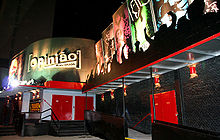
Porto Alegre is well known in Brazil for its diverse nightlife. The city's clubs, pubs, bars and restaurants provide entertainment for a wide range of tastes and budgets, going from the cheap, traditional beer-'n-bite in a corner bar to all-night raves, and classy nightclubs. The nightlife here is similar to that of New York City, but on a micro-scale. In the "SoHo" area of Porto Alegre, there is a block full of great bars, restaurants and clubs.[25]
Bars, some with live music and most with a predominantly young and trendy clientele, are spread out along, and just off, alongside the Parque Farroupilha and near the Federal University. Favourites change constantly, but the Doce Vicio, and, for dancing, the Ocidente, are usually lively. Be warned, though, that things don't get going until around llpm. Throughout the year, Porto Alegre's numerous Centros de Tradição Gaúcha organize traditional meals, music and dance performances. Tourist offices have only limited information on the events, but full details are available from the Movimento Tradicionalisto Gaticho.
Porto Alegre boasts a good popular music scene and a considerable theatrical tradition. Foreign performers of all kinds usually include Porto Alegre on any Brazilian or wider South American tour. The Sala Jazz Tom Jobim, features the city's best jazz, or there are live afternoon jazz sessions at the Cafe Concerto within the Casa de Cultura), which also has a good arthouse cinema. There are three more screens at the Espaço Unibanco (Unibanco Cultural Space), another art house cinema. Finally, the Centro Cultural Usina do Gasômetro, a converted 1920s power station on the banks of the river just west of the centre, is well worth a visit; there's always something going on in its cinema, theatre and galleries, and it also has a cafe and a good bookshop.[26]
Education
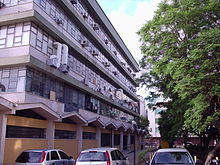
Portuguese is the official national language, and thus the primary language taught in schools. But English and Spanish are part of the official high school curriculum. There are also international schools, such as the Pan American School of Porto Alegre.
Educational institutions
- Universidade Federal do Rio Grande do Sul (UFRGS)
- Universidade Estadual do Rio Grande do Sul (UERGS)
- Pontifícia Universidade Católica do Rio Grande do Sul (PUC-RS)
- Universidade Federal de Ciências da Saúde de Porto Alegre (UFCSPA)
- Faculdades Riograndenses (FARGS)
- Escola Superior de Propaganda e Marketing (ESPM-RS)
- Faculdade Porto-Alegrense de Educação (FAPA)
- Universidade SEBRAE de Negocios (USEN)
- Centro Universitário Ritter dos Reis
- and many others.
Culture
Museums



Rio Grande do Sul Museum of Art – MARGS
With an eclectic style, the building was designed by German architect Theo Wiederspahn. Originally it was the headquarters of the Fiscal Surveillance Agency of the Federal Revenue Office. Nowadays, it hosts the largest public collection of art works in Rio Grande do Sul.
Júlio de Castilhos Museum
Created in 1903, being the oldest museum in the state. Its collection comprises thousands of pieces related to the local history, from Indian relics to objects and iconography about the War of Tatters and the War of the Triple Alliance, including an important section showing fine sculptures from the Jesuitic Reductions.
Joaquim José Felizardo Museum
An important museum with a large collection of archaeological artifacts and fotographies of Porto Alegre's old times. Its historical building, dating from 1845-55, is one of the few intact relics of colonial architecture inside the modern urban environment.[27]
Rio Grande do Sul Memorial
Showing a huge collection of documents, maps, objects, prints and other items related to the state's history. Its building, designed by Theodor Wiederspahn, is one of the finest examples of eclectic architecture in the city.
Carnival/Carnaval
The Porto Alegre Carnival began in the 18th century with the entrudo, a prank brought over by the Portuguese from the Azores, whereby people threw flour, water, and "limão de cheiro" missiles at each other. At the end of the 19th century, two important Carnival associations were born. Rivalry between the two long dominated the city's Carnival. The corso, a parade of floats down Porto Alegre's streets, was a celebration enjoyed by the more well-to-do of the city's inhabitants.[28] One of the most important Carnival personalities is King Momo. At the beginning of Carnival, usually in February, he receives the keys to the city from the Mayor of Porto Alegre, symbolically governing the Carnival during the four days of revelry. Vincente Rao was the most popular King Momo.[29]
Cuisine
One of the most famous foods of Brazil, churrasco (slow-grilled and -roasted meat), originated in Rio Grande do Sul. But cuisine is eclectic here in cowboy country, and rice and beans sit on southern tables beside Italian and German dishes, thanks to the South's many European immigrants. Look for barreado, a dish from coastal Paraná made by stewing beef, bacon, potatoes, and spices for hours in a clay pot made airtight with moistened manioc flour. Colonial coffee is the elaborate 5 PM tea, with breads, pies, and German kuchen—popular among the Germans in the South.[30]
Events

- World Social Forum: At several occasions (2001, 2002, 2003, 2005) the World Social Forum has been hosted in Porto Alegre.
- Photos World Social Forum in Porto Alegre (2001, 2003, 2005)
- Farroupilha Week: this cultural celebration takes place in mid September with parades, food and musical exhibitions.
- Bookfair: Held each November at Alfândega Square.
Infrastructure
International Airport

Salgado Filho International Airport serves flights operated by major Brazilian airlines to many areas in Brazil and other South American countries. Salgado Filho International Airport also has an air cargo terminal, built in 1974, with 9,500 thousand square meters of area and capacity to handle 1,500 tons of export cargo and 900 tons of imports each month. The average daily movement (arrivals and departures) is 174 aircraft, flying scheduled routes connecting Porto Alegre directly or indirectly to all the country's other major cities, as well as smaller cities in the interior of the states of the South Region and São Paulo. There are also international flights with direct connections to cities of the Southern Cone.
With 37.6 thousand square meters of constructed area and four levels, the passenger terminal at Porto Alegre International Airport can receive 28 large airplanes simultaneously. The terminal has 32 check-in counters, ten boarding bridges, nine elevators and ten escalators. It has a totally automated aircraft movement control center and the main spaces are air conditioned. The apron, surfaced with prestressed concrete, can serve jumbo jets like the Boeing 747-400. The garage structure has eight levels, 44 thousand square meters and 1,440 parking spaces. Another terminal, with 15 thousand square meters and capacity for 1.5 million passengers a year, serves general, executive and third-tier aviation (conventional piston-engine and turboprop planes). The Aeroshopping area, a center for commerce and leisure, operates 24 hours a day with shops, services, a food court, along with a triplex cinema, the first to be established at a Brazilian airport.[31]
Port

The Port of Porto Alegre is situated in the Eastern margin of lake Guaíba. Its geographical position enables a permanent traffic between Porto Alegre and Buenos Aires, transporting steel-industry products and mainly agricultural produce.
Metro
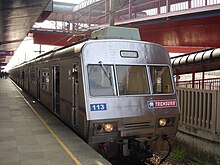
The metro is operated jointly by the federal government, the state government of Rio Grande do Sul and the city of Porto Alegre through the company Trensurb (Company of Urban Trains of Porto Alegre) and has 17 stations, totaling 42 kilometres (26 mi) of extension, carrying about 130,000 users a day.
The Line 1 of the subway built in Porto Alegre was started in 1980, linking the center of Porto Alegre to cities to the north of the metropolitan area, as Canoas, Esteio, Sapucaia do Sul, São Leopoldo and Novo Hamburgo. The choice of path was made to relieve the heavy traffic of highway BR-116, only option before the construction of this line, which already had serious problems with the transit at the time. The Line 1 was inaugurated on March 2, 1985 between the Central Public Market and Sapucaia do Sul. In December 1997 was extended to Unisinos. An extension of 2.4 miles São Leopoldo-Museum was added in November 2000, after two months of trial service.[32]
Highways

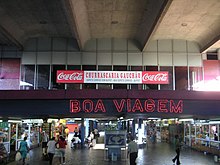
There are only two highways on the city, and they roughly border the North and the Northwest sides of the city. This is so because even though this is the capital city and most populous in the region, there are no major destinations to the southeastern and southern of Porto Alegre (regarding the east side of Lagoa dos Patos). BR-290 runs across the state East-West, linking the Northeast coast of the state to the Uruguay-Argentina-Brazil border. It runs across the north border of the municipality.
BR-116, which runs Northeast-South across the state, linking the city to most of its satellite cities and most of Brazil northbound, and to eastern Uruguay southbound. Within the municipality, it only touches the Northwest side of the city, close to the end of Rio Gravataí (Gravataí River). Avenida Presidente Castelo Branco (Castelo Branco President Avenue), also bordering the Northwest side of the city, is a rather short (4 kilometres (2.5 mi)) highway and the only one that is fully contained within the borders of the municipality. It links downtown with these other highways.
This city has a nice transporation system, especially the autobuses. One of the bus companies is named Carris, what is considered the best autobus company in Brazil. The city has also mini-buses from and to all the main neighborhoods in the city, very comfortable and just a few more boxes than the regular bus, and in the mini-buses people will be always seated as it's forbidden to transport passengers standing. Linha Turística (Tourist Line) is a bus that leaves from Usina do Gasômetro tourist terminal around six times per day. During 90 minutes, it traverses the various districts of Porto Alegre. For a modest price of R$ 5.[33]
Sports

Football is a passion of the people from Porto Alegre. There is a big rivalry between two football clubs,Grêmio Foot-Ball Porto Alegrense, founded in 1903. And Sport Club Internacional, founded in 1909. The regional championship is usually won by one of these teams. The confrontation between Grêmio and Internacional is known as Gre-Nal. Both teams already won the main championships possible to South American clubs: the Copa Libertadores and the Club World Championship.
Porto Alegre is one of the host cities of the 2014 FIFA World Cup, for which Brazil is the host nation. Despite not having CBF and FIFA's official confirmation, Globo Esporte site believes that five cities are practically confirmed as host cities: Rio de Janeiro, São Paulo, Belo Horizonte, Porto Alegre and Brasília. For the 2014 World Cup Extraordinary Secretary, José Fortunati, "the change increases the expectation. It is evident that we would like to know the result of the 5 chosen cities as soon as possible. However, we will use the extra time to have a broad discussion together with the population about the importance this sport event will have for future of the city," he enhanced, saying that the differentials of the gaúcha candidateship will be emphasized. Lectures and exhibitions will be promoted in institutions, universities and associations of the civil society from the month of April on." It will be a great opportunity to show the work we have developed until the moment and to project the development legacy that the World Cup will bring to Porto Alegre" emphasized Fortunati.[34]
The modernization process of Beira-Rio Stadium – Giant Forever (Gigante Para Sempre) – advances with the completion of each planned step. On Feb. 19th , the club received from Planning Secretary Márcio Bins Ely, the City Declaration of the urban conditions of land occupation regarding the area of the old Eucaliptos Stadium. "This document permits a thorough evaluation of the area's worth", stated president Vitorio Piffero on the club's site.
Authorized by the Consulting, Deliberative, and Fiscal Councils, Internacional will sell the area and use the money exclusively for the enhancement and renovation of the Beira-Rio Complex as part of the modernization project "Gigante Para Sempre", also having in view the 2014 World Cup. The Complementary Law which alters the urban regimen in the old Eucaliptos Stadium area was approved last December by the City Chamber of Representatives and sanctioned by Mayor José Fogaça on Jan. 8th , 2009. The DM (City Declaration) is the first step for requiring approval and licensing of building or activity projects with Porto Alegre"s City Hall, informing the urban regimen and the legal conditionings of the required area. Now, being able to make the correct evaluation of the area, Sport Club Internacional can define the date for launching the sales edict and consequently get the guarantee of resources to be invested in Beira-Rio"s renovation.[35]
Sister cities
Porto Alegre's sister cities are:[36] [37]
Neighborhoods
Neighborhoods of Porto Alegre are geographical divisions of the city. There is no devolution of administrative powers to neighborhoods, although there are several neighborhoods associations devoted to improve their own standards of living. Porto Alegre has nowadays 78 official distinguished neighborhoods and 4 territories.
See also
References
- ^ Vegetation in the city
- ^ History of Porto Alegre
- ^ [1]
- ^ [2]
- ^ "Weatherbase: Historical Weather for Porto Alegre".
{{cite web}}: Unknown parameter|dateformat=ignored (help) - ^ Síntese de Indicadores Sociais 2008 (PDF) (in Portuguese). Porto Alegre, Brazil: IBGE. 2008. ISBN 85-240-3919-1. Retrieved 2009-01-31.
- ^ RS VIRTUAL - O Rio Grande do Sul na Internet - História - Colonização - Portugueses - Origem da imigração açoriana
- ^ http://www.atlasesportebrasil.org.br/textos/229.pdf
- ^ RS VIRTUAL - O Rio Grande do Sul na Internet - História - Colonização - Alemães - Dezebas de colônias no interior e 50 mil imigrantes
- ^ Germans from the interior of the state in Porto Alegre
- ^ RS VIRTUAL - O Rio Grande do Sul na Internet - História - Colonização - Italianos - A maior parte veio do Vêneto
- ^ Polish Brazilian in Porto Alegre
- ^ Japanese Brazilian in Porto Alegre
- ^ Jew Brazilian in Porto Alegre
- ^ Barsa Planeta Ltda
- ^ Porto Alegre, Brazil by Sergio Koreisha
- ^ Solidary economy in Porto Alegre
- ^ Porto Alegre
- ^ Technology Industry - CEITEC
- ^ Porto Alegre - Economy
- ^ GDP (PDF) (in Portuguese). Porto Alegre, Brazil: IBGE. 2006. ISBN 85-240-3919-1. Retrieved 2009-07-21.
- ^ per capita income (PDF) (in Portuguese). Porto Alegre, Brazil: IBGE. 2006. ISBN 85-240-3919-1. Retrieved 2009-07-21.
- ^ a b c http://siteresources.worldbank.org/INTEMPOWERMENT/Resources/14657_Partic-Budg-Brazil-web.pdf
- ^ a b c Porto Alegre's Budget Of, By, and For the People by David Lewit
- ^ Nightlife POA city
- ^ Nightlife Porto Alegre
- ^ Joaquim José Felizardo Museum
- ^ Carnival of Porto Alegre
- ^ King Momo - Carnival, Porto Alegre
- ^ Cuisine in Porto Alegre
- ^ Salgado Filho International Airport - Infraero
- ^ Metro (Porto Alegre)
- ^ Bus in Porto Alegre
- ^ FIFA's confirmation - Porto Alegre
- ^ Sport plans - Porto Alegre 2014 World Cup
- ^ a b c d e f g h i j k l m n "Mayor's International Council Sister Cities Program". Porto Alegre, RS. Retrieved 2008-08-22.
- ^ a b "Partners cities from Paris". Porto Alegre, RS. Retrieved 2009-07-19.
External links
- Template:Pt icon Transclusion error: {{En}} is only for use in File namespace. Use {{lang-en}} or {{in lang|en}} instead. Porto Alegre Convention & Visitors Bureau page
- Template:Pt icon Official homepage (some pages available in Transclusion error: {{En}} is only for use in File namespace. Use {{lang-en}} or {{in lang|en}} instead.)
- Template:Wikitravel
- Template:Pt icon Maplink - Porto Alegre Street Guide and Maps
- Template:Pt icon Calendar of Events and Histories of the Neighborhoods of Porto Alegre
- Template:Pt icon Postal Cards of Porto Alegre
- Template:Pt icon History, Old and Actual Photos, Parks History, Porto Alegre maps, Brazilian Hymns and another stuffs about the city


